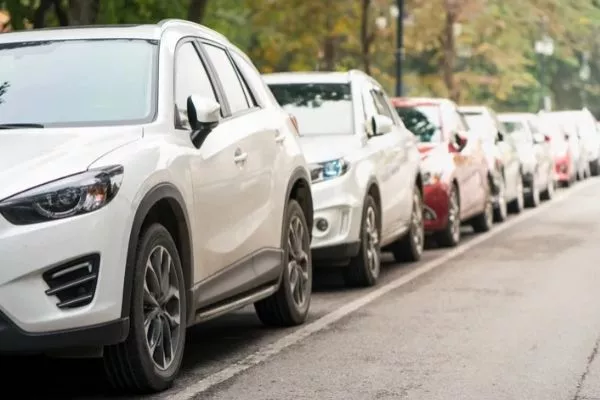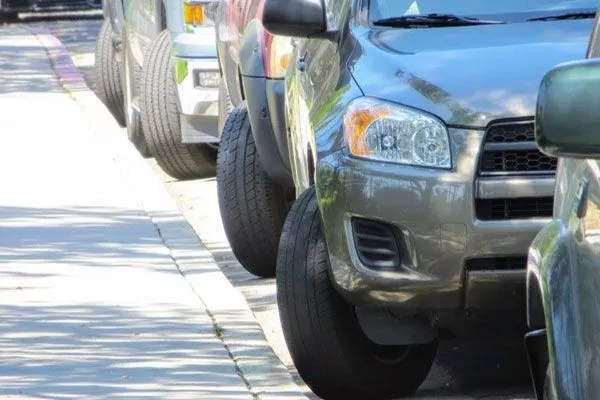Essentially, parking is stopping a vehicle, disengaging its engine, and leaving it unattended, this is one of the first lessons you learn in driving school, because it makes no sense to just leave your car in the middle of the road.
But did you know though that there are different parking types? While many experienced drivers have performed these countless times, there’s no harm in actually knowing what they're called, right?

In the Philippines, parking can get chaotic.
For those who are still learning to drive, this article will help you familiarize yourself with the different parking types; in these situations, your parking techniques might require some tweaking. That’s what Philkotse.com is going to teach you in this article about optimal parking techniques.
1. How to park a car: Perpendicular parking
Perpendicular parking is similar to angled parking, in that you’re expected to park beside other cars or even in-between them. if it sounds scary, don’t fret. Here’s what you need to do:
-
First, turn your signal lights on. This alerts other drivers to what you’re doing and where you’re going. Approach the parking space slowly and allow around 8 feet of distance between your car and the other car or cars already parked in the row.
-
When your front bumper is beyond the taillights of the parked car, turn your wheel.
-
If you estimate that your car’s already halfway into the parking space, straighten your front wheels. Stop when you see the curb is lined up with the bottom part of your side mirror.
-
Engage the parking brake and place your gear in Neutral (for manual transmissions) or Park (for automatic transmissions).

Strangely enough, a lot of malls in the Philippines use perpendicular parking
>>> You may like to read:
- 4 rules to avoid car accidents when parking
- Why is parking car in reverse better & How to park properly in reverse?
2. How to park a car: Angled parking
Angled parking spaces are usually found in places where the vehicle turnover rate is high; this means places like malls and large gas stations where people come and go quickly. This is because angled parking is easy to get in and out of. In this parking type, vehicles are usually positioned front-end first into a parking slot. Here’s the parking tutorial for angled parking.
-
If you’ve found a vacant parking spot, turn on your turn indicators towards the direction of where you’re going to park, while checking for incoming traffic.
-
Line up your side mirrors with the parking line closest to you. Turn your steering wheel and proceed slowly into the vacant spot.
-
Continue moving forward until your car is lined up with the other cars next to you. Always note the endpoint of the parking lot, whether it’s a wall, a curb, and especially if it’s just a line painted on the ground.

Angled parking is probably the easiest parking type to perform
>>> Worth your reading: Careless parking can destroy your car tires
3. How to park a car: Parallel parking
This type of parking is when you’re parking your car alongside, or parallel to, the road and in line with other vehicles both in front and behind you. For many new drivers, parallel parking is one of the most difficult skills to learn, but it’s a major part of the LTO exam to get your license.
Some manufacturers have even included an “automatic parking” or “parking guidance feature” on their newer models, to help inexperienced drivers perform proper parallel parking.
Here are the parking techniques on how to parallel park.
-
Line up your vehicle along the empty slot at a distance of around two feet. If the parking space is on the left, turn your wheel all the way to the left; if it's on your right, turn your wheel right. Don’t forget to turn on your signal light.
-
Slowly back up your car to a 45-degree into the parking space. One trick to determine if you got it right is by glancing at the license plate of the vehicle behind you on your side mirror.
-
Next, straighten the front wheels, then slowly back up. At this point, it might be helpful to have someone guide you, especially if you’re still a novice and you don't have a rear camera or rear sensors.
-
When you've noticed the corner of your front bumper is level with the rear bumper of the car in front of you, stop backing up.
-
Turn your steering wheel to the right if the parking space is to your left, or vice versa. This maneuver will cause your car to slot into the empty parking space.
-
Adjust as needed while applying the foot brake. Once you find the optimal position, put your gear selector in Neutral or Park, engage the parking brake, and turn off the engine.
>>> For more detailed tips on parallel parking, check out: Parallel parking tips: The definitive guide to parallel parking in the Philippines

A row of cars parked in parallel
4. How to park a car: Downhill or uphill parking
Parking uphill tips
When you need to park on an uphill slot, activate your turn indicators towards the direction you’re parking. If you’re parallel parking on a hill, apply the steps above, else you can just pull alongsids the slot you intend to park on.
Whether you're parked on the left or right side of the road, turn your front tires away from the curb; by doing this, they will act as a backup in case your parking brake fails, making your car roll into the curb instead of continuing onwards downhill.
When you've already parked facing uphill, place your shifter on first gear as an extra safety measure.

A classic truck parked uphill. Note the angle of its tires
>>> Related post: Learn about the Hill-start Assist Control (HAC) & Downhill Assist Control (DAC)
Parking downhill tips
When you intend to park downhill, point your wheels toward the curb. As in uphill parking, this will serve as a backup in case the parking brake fails; the car will gently roll toward the curb instead of continuing downhill.

Several cars properly parked downhill
How to park a car uphill or downhill without a curb
If there’s no curb, turn your wheels in a way that it will roll away from the road whenever the brakes fail. Do this by turning to the right.
5. How to park a car: Parking etiquette
While learning to drive is a must, another crucial thing you should be familiar with is parking etiquette. After all, we live in a society and one of the biggest peeves you’ll encounter in modern society are jerks with cars.
In the context of Metro Manila where traffic is nightmarish and parking is a scarce resource, there are times when even the smallest breach in good driving manners might result in road rage.
So, to avoid becoming a road rage victim or worse, a statistic, here are several basic parking tips for proper parking etiquettes.
Avoid blowing your horn
When parking, try to avoid using your horn, with the lone exception being when another vehicle is about to hit your car. Why? Some drivers interpret horn-honking as a sign of impatience or misplaced entitlement, taking undue offense. At best, you’ll get a rude remark or gesture; at worst, you'll find yourself being challenged to a fistfight or staring down the business end of a deadly weapon.
Parking lot etiquette: park it like a pro
Only park in places where your car will fit
To save everyone's time, try not to force your big-ass SUV in a space meant for compact cars. Aside from the damage you'll risk on your car and the surrounding vehicles, you wouldn't want to be trapped inside your SUV, right?
Also, take note of the ride height on your tall truck, for when you encounter parking facilities that have a limited maximum clearance.
Use your turn signals
Most drivers are not psychics; they can't read your mind and tell where you're going. So please use your turn signals when you begin a parking maneuver. Also, if you’re waiting for a particular parking space, use your hazard lights to let other people know that you’re on standby. Also, if you’re the one about to leave, make sure to signal other drivers who are still looking for a spot; they’ll appreciate it.

Taking up more than one parking slot is not cool, no matter what car you drive
Drive slowly on parking lots
Expect parking lots to be teeming with people, be they drivers walking to and from their cars or passengers waiting to be picked up. In either case, drive at a slow pace to avoid running over them.
Be patient and try to stay calm
Even if you feel that you’re right and the other driver is wrong, always take the high road; stay calm and let the other party vent it out. If they try to physically assault you, protect yourself by staying inside the car or call the attention of security personnel for help.
Follow the law and don’t just park anywhere.
Don’t park in places where there is a no parking signage present, and don’t park on slots reserved for PWDs if you're not one or you're not driving with one. If you’re unsure whether you're allowed to park at a particular spot or not, try to ask first.
Be aware of your surroundings and double-check whether or not the way your parked will affect other cars. Will they be able to get out if you park in a particular spot? If not, then find another parking spot.
Recent posts
- List of cheap parking in Makati: Rates, Opening hours & more Aug 16, 2022
- Start a parking business: A complete guide to design a car park Apr 17, 2020
- The Guide to Parking at Naia Terminals: Rates, Advice & More Nov 30, 2022
- The guide to paid parking and parking spaces for rent in Manila Aug 16, 2022
- How to stop your neighbor from parking in your driveway? Aug 04, 2020












